the place where Paleontology and Paleoanthropology meets Philately
Ukraine
Prehistoric animals, fossils, paleontologists on stamps, postmarks and postal stationery and commemorative covers of Ukraine
| << previous country | back to index | next country >> |
Contents:
- Country overview
- Philately of Ukraine
- Official stamps of Ukraine related to Paleontology and Paleoanthropology
- Some other stamps of Ukraine to consider
- Postal stationery and commemorative covers of Ukraine related to Paleontology and Paleoanthropology
- Commemorative postmarks of Ukraine related to Paleontology
- References
- Acknowledgements
Ukraine, is a sovereign state in Eastern Europe, has an area of 603,628 km2 and a population of about 42.5 million.
Ukraine is the largest country entirely within Europe. It's about the same size as Germany, Austria, Switzerland, Portugal and Belgium combined.
The geographical center of Europe is in western Ukraine – close to the village of Dilove. claim made by geographers in 1886 using the technology of the day.
The territory of modern Ukraine has been inhabited since 32,000 BC. During the Middle Ages, the area was a key centre of East Slavic culture, with the powerful state of Kievan Rus forming the basis of Ukrainian identity.
Following its fragmentation in the 13th century, the territory was contested, ruled and divided by a variety of powers, including Lithuania, Poland, the Ottoman Empire, Austria-Hungary and Russia.
A Cossack republic emerged and prospered during the 17th and 18th centuries, but its territory was eventually split between Poland and the Russian Empire and later merged fully into Russia.
Two brief periods of independence occurred during the 20th century, once near the end of World War I and another during World War II.
However, both occasions would ultimately see Ukraine's territories consolidated into a Soviet republic, a situation that persisted until 1991, when Ukraine gained its independence from the Soviet Union in the aftermath of its dissolution at the end of the Cold War.
Before its independence, Ukraine was typically referred to in English as "The Ukraine", but sources since then have moved to drop "the" from the name of Ukraine in all uses. [R1]
In 1918 an independent Ukrainian People's Republic was established and a series of five definitive stamps were issued.
Ukraine used the stamps of the Soviet Union from 1919 until the end of 1991, apart from during World War II.
After the collapse of the Soviet Union, Ukraine declared its independence and the first stamps of the new republic were issued on 1 March 1992.
In 1992 the Ukrainian Post Office overprinted stamps of the Soviet Union with stylised tridents for use in Kiev, Lviv and Chernihiv.
Other Soviet stamps overprinted with similar designs are not believed to have been postally valid. Since 1992, a variety of commemorative and definitive stamps have been issued. [R2]
 |
 |
On February 24th, 2022 Russian army invaded Ukraine territory and currently bombing peaceful cities and killing civilians all over the territory of Ukraine.
Please think twice if you want to buy anything from Russia, even some stamps or covers, and indirectly support their aggression against Ukraine, free and independent European country.
I'm, Michael Kogan admin and owner of this website, call all my visitors from around the world to boycott Russia - don't give your money to the country to kill Ukrainian citizens and destroy Ukrainian cities.
Boycott Russia - Save Ukraine !
www.ukraine-war-in-philately.eu - Ukrainian resistance to Russian aggression through Philately.
Official stamps of Ukraine related to Paleontology and Paleoanthropology: prehistoric animals and humans
| 20.01.2017 "The Palaeolithic Age" | ||
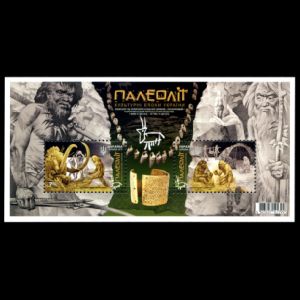 |
|
|
Some stamps of Ukraine to consider: Amber, Universities with Paleontology faculties
| 31.12.2010 "Minerals" [O1] | 11.10.2011 "350th Anniversary of Lvov National University" [O2] | 27.07.2019 "Mezyn National Nature Park" [O3] |
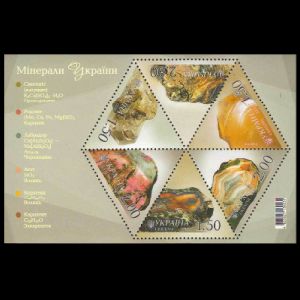 |
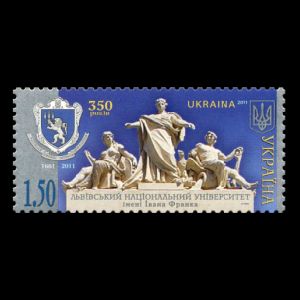 |
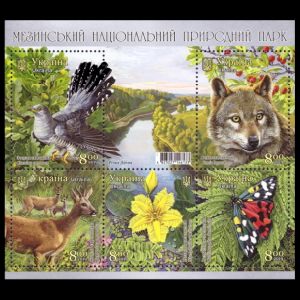 |
| 15.12.2021 "Amber" [O4] | ||
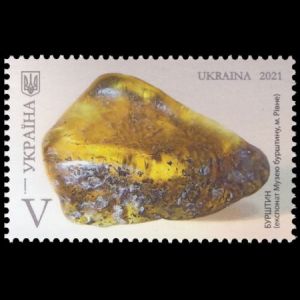 |
|
|
Notes:
[O1] Amber (fossilized tree resin) is depicted on one of the stamps
[O2] Ivan Franko national University of Lviv is the oldest university in Ukraine, established in 1661.
The university, one of the leading national Universities in training experts for education, research and industry in Ukraine, was renamed for the great national Ukrainian writer, poet, and statesman, Ivan Franko (1856-1916).
The University was granted the prestigious status of National on 11 October 1999. It was awarded the highest, fourth level of accreditation by the Ministry of Education and Science of Ukraine .
The Geology division of the University has Paleontology sub-division and a Paleontological museum.
The Paleontological Museum exhibits a unique collection of Mammoths.
There are also displays on the artifacts of primitive people found in the territory of Western Ukraine.
The most valuable samples in the Museum are the paleontological collections of Mesozoic and Cenozoic fossils [R4]
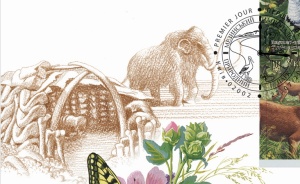
|
| Mammoth and dwelling of hunters for mammoths on cachet of an FDC with Mezyn National Nature Park stamps of Ukraine 2019. |
[O3] Mammoth and its bones shown on a cachet and postmark of FDC with "Mezyn National Nature Park" stamps set.
The "Mezyn National Nature Park" covers an area of more than 30 thousand hectares. The landscape of the park includes many lakes.
Besides the landscape, the park also hosts approximately 50 archaeological monuments. The archaeological monuments represent different eras and cultures – including archaeological, architectural and historical monuments in the villages of Buzhanka, Kurylivka, Sverdlovka, Radychiv and others.
The most noted is Mezyn Paleolithic Camp that existed almost 20 thousand years ago.
Ukrainian stamps from 2017, “"The Cultural Epochs of Ukraine: Paleolithic Age" show reconstructions of this site. A reconstruction of a woolly mammoth is also shown on the postmark of the FDC.
[O4] New stamp from the multi-year set "Beauty and Greatness of Ukraine" was dedicated to the Rivne region and shows a piece of amber from the collection of the Amber Museum in Rivne, Ukraine.
Amber is a fossilized resin of the ancients conifers growing in the area of Rivne region.
The amber is dated between Late Eocene and Early Miocene (about 37-50 million years ago) and suggested to be contemporaneous to Baltic amber.
For more details click here.
Official illustrated covers and postal stationary related to Paleontology: fossils, prehistoric animals, paleontologist
| 12.09.2008 "100th anniversary of discovery of Mezyn Paleolithic Site." [O3] [PM1] | 31.07.2009 "Unearth animals of Staruni, Ivano Frankovsk" | 11.11.2011 "Andrusov Nikolay Ivanovich geologist and paleontologist" |
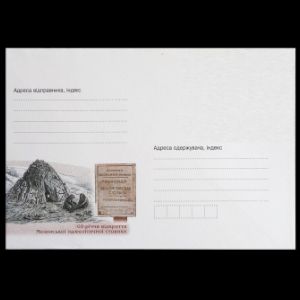 |
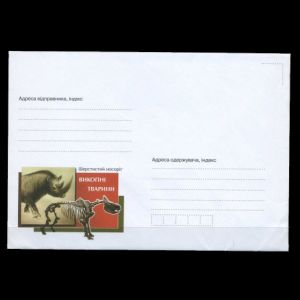 |
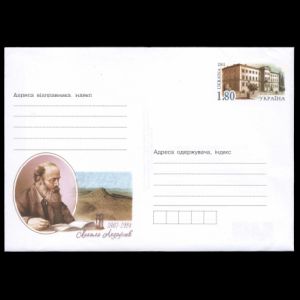 |
| 05.07.2012 "Borisyak Aleksej Alekseevich geologist and paleontologist" | ||
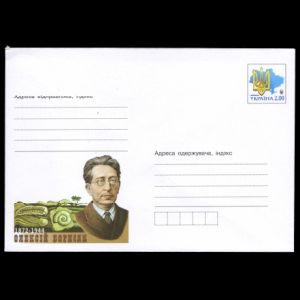 |
|
|
Commemorative postmarks of Ukraine related to Paleontology and Paleoanthropology: prehistoric animals and humans
Legend is here| 11.11.2011 "Andrusov Nikolay Ivanovich geologist and paleontologist" [Sp] | 27.07.2019 "Mezyn National Nature Park" [O3] [FDC] | |
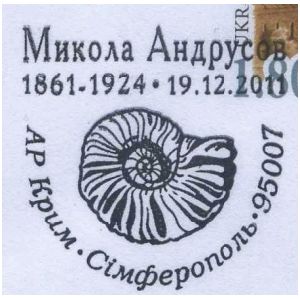 |
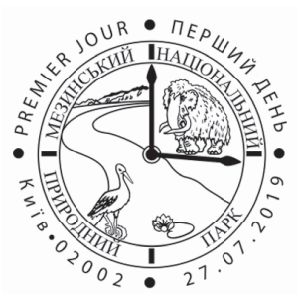 |
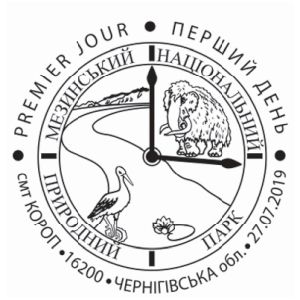 |
Notes:
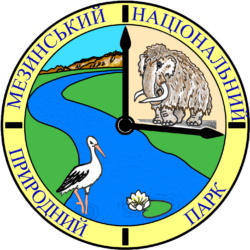
|
| Logo of Mezyn National Nature Park |
The postmark was issued in two locations: Kyiv (the capital of Ukraine) and Korop (an urban-type settlement - селище міського типу in Ukranian - or just смт as written on the postmark). Korop is the regional centre, near Mezyn village.
The park spread over 30.000 hectares, is covered with many lakes and it is a home for many animals and plants.
A museum in Sverdlovka provides information about the Park – including information on the climatic, geographic and other features of the park.
It also exhibits collections of insects, mosses, and geologic materials.
Beside the unique natural complexes and objects the park boasts about 50 archaeological monuments.
The most important is Mezyn Paleolithic Site. Remains of over 100 individual mammoths and many remains of other mammals, are found at the site.
Reconstruction of one of the mammoths is shown on the top-right corner of the Logo and the postmark. [R3]
References:
- [R1] Ukraine: Wikipedia, FlagCounter
-
[R2] Postal History and Philately of Ukraine:
Wikipedia
Links to official website of the Post Authority, stamp catalog and a list of new stamps of Ukraine are here - [R3] Mezyn National Nature Park: official website of the park (in Ukrainian), siver.org.ua.
-
[R4] Ivan Franko national University of Lviv:
official website
The Geology division of the University Wikipedia (in Ukrainian), Paleontological Museum Of The Lviv National University: < ua-travel.info (in Russian).
Acknowledgements:
Many thanks to
- Dr. Peter Voice from Department of Geological and Environmental Sciences, Western Michigan University, for the draft page review and his valuable comments.
- Mr. Alexander Pedchenko from Russia, for his help in finding some missing philatelic stuff of Ukraine.
| << previous country | back to index | next country >> |